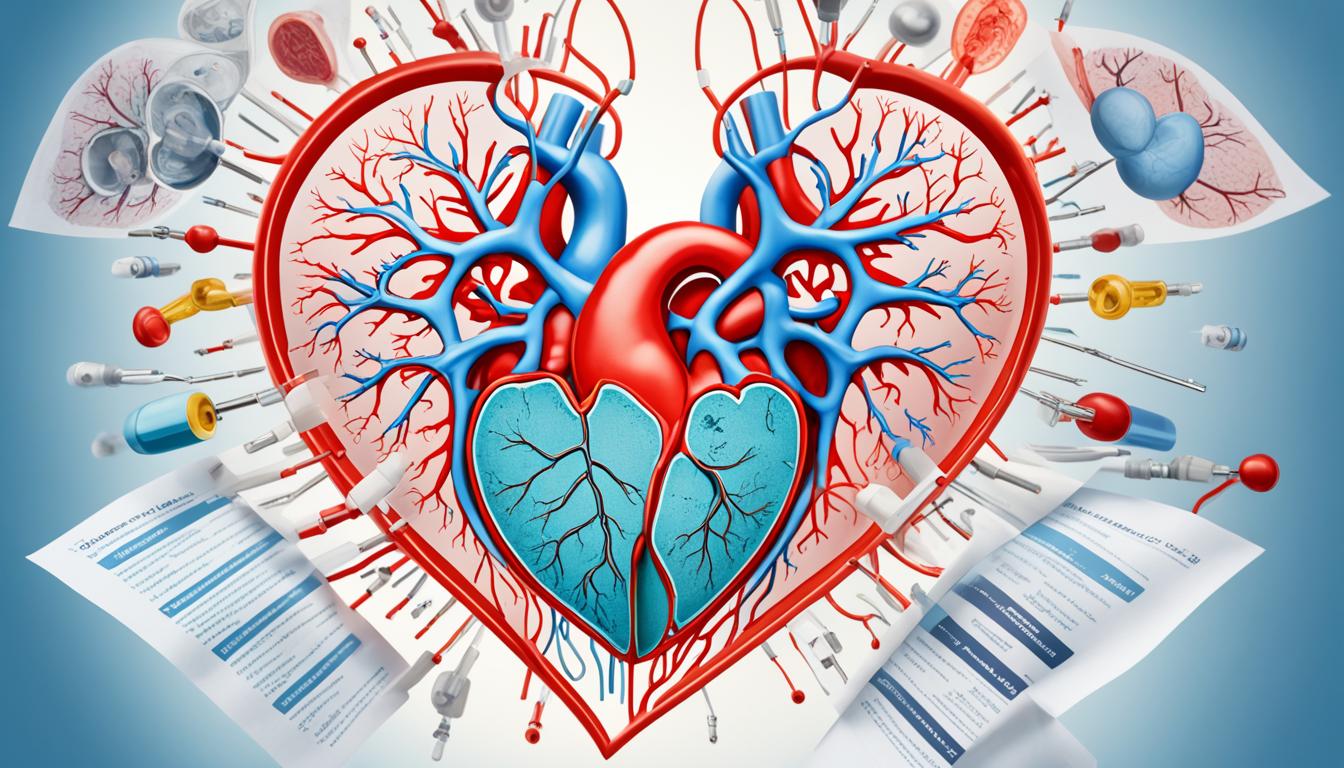Congenital heart defects are issues with the heart’s structure present at birth. They range from simple problems not needing treatment to complex ones needing many surgeries. They affect about 6 to 13 out of 1000 babies born.
Serious heart defects may show themselves with rapid breathing, a blue tint to the skin, and slow weight gain. The causes aren’t always clear, but things like diabetes, drinking, and smoking during pregnancy might be involved.
Getting treated could mean procedures that involve tubes, open chest surgeries, a new heart, or medicines. But most importantly, kids with these heart problems need ongoing care to live well.
Key Takeaways:
- Congenital heart defects are structural abnormalities of the heart that occur before birth.
- Symptoms may include rapid breathing, bluish skin color, and poor weight gain.
- Risk factors for congenital heart defects include diabetes, drinking alcohol during pregnancy, and smoking during pregnancy.
- Treatment options include catheterization procedures, open-heart surgery, heart transplant, and medication.
- Long-term monitoring and care are essential for managing congenital heart defects in children.
Diagnosis of Congenital Heart Defects in Children
Finding congenital heart defects in kids is key to giving them the right care. It might start with noticing a heart murmur. This sound can mean something’s not right with the heart. Doctors then use different tests to check the heart’s structure and how it works:
- Fetal echocardiogram: A special ultrasound helps see the baby’s heart while still in the womb.
- Echocardiogram: This test makes detailed images of the heart using sound waves. It looks at how the heart muscles and valves work.
- Electrocardiogram (ECG): A simple, painless test that checks the heart’s electrical activity. It spots any issues.
- Chest X-ray: Pictures of the chest show the heart’s shape and size. They also help find heart conditions.
- Pulse oximetry: It’s a quick way to measure how much oxygen is in the blood. This test can catch some heart problems.
- Cardiac catheterization: This test gives very detailed heart information. A thin tube is put into the heart to take pictures and measurements.
All these tests together help doctors figure out the congenital heart defect’s type and how serious it is. Knowing this, they can make a plan for each child’s care.
Treatment Options for Congenital Heart Defects in Children
Congenital heart defects come in many types and levels of seriousness. Less severe defects might fix themselves. But, critical ones need quick treatment.
For some defects, doctors use catheterization procedures. These are not as invasive and include fixing things like balloon valvuloplasty or closing septal defects. Doctors insert catheters through blood vessels to reach and repair the heart without surgery.
If the defect is complex, open-heart surgery might be needed. This surgery can fix or replace heart valves, correct blood vessel positions, and deal with other big heart problems.
When the case is very severe, a heart transplant could be the best choice. This replaces a diseased heart with a healthy one from a donor. Heart transplants are for children facing life-threatening heart problems with no other treatment options.
Medications are also important in managing congenital heart defects. Doctors might prescribe them to reduce symptoms, control blood pressure, or lower infection and clotting risks. The specific medicines and doses will be based on each child’s condition.
Long-term health for children with these heart defects needs careful monitoring and care. This means regular doctor visits, tests, adjusting treatment plans, and supporting the child and their family throughout.
Treatment Options for Congenital Heart Defects in Children
| Treatment Option | Description |
|---|---|
| Catheterization Procedures | Minimally invasive techniques using catheters to correct certain defects, such as balloon valvuloplasty and closure of septal defects. |
| Open-Heart Surgery | Surgical procedure involving repairing or replacing heart valves, correcting blood vessel positioning, and addressing complex heart abnormalities. |
| Heart Transplant | Procedure where the diseased heart is replaced with a healthy donor heart, typically reserved for life-threatening heart conditions. |
| Medications | Prescribed to manage symptoms, control blood pressure, prevent infections, and reduce the risk of blood clots. |
Doctors aim to enhance the health and life quality of children with heart defects. They do this with the right mix of treatments and ongoing care.
Conclusion
Congenital heart defects in kids are a major health issue, impacting many newborns globally. It’s key to diagnose early, treat correctly, and offer ongoing care to manage these issues well.
Thanks to medical and surgical progress, outcomes for these kids have gotten much better. They can now have active and fulfilling lives. Yet, we still need more research and advances in pediatric cardiology to improve their options and outcomes.
With the right medical support, children with heart defects can live full, thriving lives.

